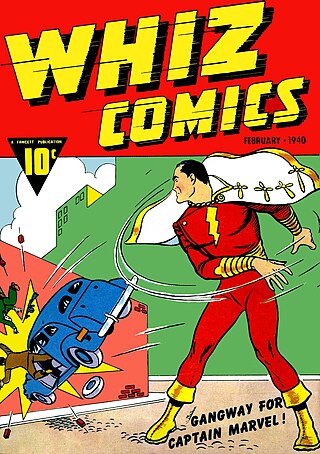
A superhero or superheroine is a stock character who typically possesses superpowers or abilities beyond those of ordinary people, is frequently costumed concealing their identity, and fits the role of the hero; typically using their powers to help the world become a better place, or dedicating themselves to protecting the public and fighting crime. Superhero fiction is the genre of fiction that is centered on such characters, especially, since the 1930s, in American comic books, as well as in Japanese media.
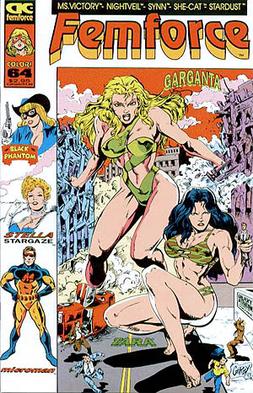
Femforce is a comic book published by AC Comics that began publication in 1985, detailing the adventures of the titular team: the "Federal Emergency Missions Force" or "Femforce", some of them original creations, while others originated in the 1940s and 1950s, lapsing into public domain by the time Femforce was published. The team are, as their name implies, all superheroines, and are the first and the longest running all-women 'super-team'. The series has passed 150 issues, a significant milestone for an independent comic book company. Writers on the book have included Bill Black, Stephanie Sanderson, Mark Heike, Paul Monsky, Enrico Teodorani and Francesca Paolucci. Artists on the book have included Bill Black, Stephanie Sanderson, Mark Heike, Brad Gorby, Jeff Austin, Dave Roberts and Rik Levins.
Dial H for Hero is a comic book feature published by DC Comics about a magical dial that enables an ordinary person to become a superhero for a short time, such as an hour, by selecting the letters H-E-R-O in order. Each time it is used, the dial causes its possessor to become a superhero with a different name, costume, and powers. These superheroes are usually new, but on one occasion the dial caused its user to become a duplicate of Plastic Man. Some versions of the dial, like the original, contain additional letters, allowing other kinds of transformations. The title of the series is a play on the title of the 1954 American crime mystery film directed by Alfred Hitchcock titled Dial M for Murder.
Cutey Bunny is a cartoon animal superheroine created by Joshua Quagmire for a humorous line of American underground comic books that first appeared through Army Surplus Komikz, which ran sporadically for five issues from 1982 to 1985. She has since appeared through various other comic titles such as Critters from Fantagraphics Books and one-shots such as Cutey Bunny's Pearl Harbor Beach Party from Rip Off Press. As her name suggests, Cutey Bunny's powers and concept are a pastiche of Go Nagai's manga creation, Cutey Honey.

Doctor Anthony Druid, also known as Doctor Droom and Druid, is a fictional mystic and a supernatural monster-hunter appearing in American comic books published by Marvel Comics. Co-created by writer-editor Stan Lee and penciller Jack Kirby, he debuted as Dr. Anthony Droom in Amazing Adventures #1, published in March 1961. Kirby's art was inked by artist Steve Ditko. Dr. Droom appeared in four more issues of Amazing Adventures before his stories discontinued. Over a year later, artist Steve Ditko approached Stan Lee with a new magic character called Mr. Strange. Liking the idea, Stan Lee renamed the character Dr. Strange and wrote an origin story similar to Dr. Droom's. Dr. Anthony Droom was finally reintroduced to comics in 1976 in Weird Wonder Tales #19 in a retelling of his origin story which renamed him Dr. Anthony Druid. This retelling included new writing by Larry Lieber.

Miss America is a superhero appearing in American comic books published by Marvel Comics. Created by writer Otto Binder and artist Al Gabriele, the character first appeared in Marvel Mystery Comics #49 in the Golden Age of Comic Books. Madeline Joyce is the first incarnation of Miss America. The character has also been a member of the Invaders, Liberty Legion, and All-Winners Squad at various points in her history.
The American Crusader is a superhero who originally appeared in Thrilling Comics #19. He appeared in almost every issue until #41.

Black Widow is a character appearing in American comic books published by Marvel Comics. Created by writer George Kapitan and artist Harry Sahle, the character first appeared in Mystic Comics #4, published by Marvel predecessor Timely Comics. Claire Voyant is a medium who has been murdered and became the demonic "ambassador" of Satan on Earth. She kills evildoers in order to deliver their souls to her master.

The Fighting Yank is the name of several superheroes, first appearing in Startling Comics #10.

The Blonde Phantom is a fictional masked crime fighter appearing in American comic books published by Marvel Comics. Created for Marvel predecessor Timely Comics by Stan Lee and Syd Shores, the character first appeared in All Select Comics #11, during the 1940s period fans and historians call the Golden Age of Comic Books. The heroine was so well received that the next issue was retitled The Blonde Phantom. The series continued to feature her until issue #22. She also appeared in backup stories in many other Timely comics; in Superhero Comics of the Golden Age, Mike Benton observes that "for a few months in 1948, readers could find her in seven titles on the newsstand." In The Supergirls, Mike Madrid asserted, "Once again, a capable woman hid behind a meek persona and only let her hair down, literally, to come to the aid of a man who completely ignored her unless she assumed a disguise. In a 1947 story entitled "I Hate Myself", Louise even dreams that Mark finally confesses his love for her, only to have the Blonde Phantom persona appear and steal him away."

Betsy Ross is a character appearing in American comic books published by Marvel Comics. Created by Joe Simon and Jack Kirby, the character first appeared in Captain America Comics #1. Betsy Ross is Captain America's early love interest and supporting character in American comic books published by Marvel Comics during the 1930-1940s period known to historians and collectors as the Golden Age of Comic Books. She then debuted as the superheroine Golden Girl in Captain America Comics #66.

Yankee Girl is the name of two superheroines each debuting during the 1930s and 1940s Golden Age of Comic Books. One was revived in the 1990s.

The Woman in Red is a fictional character that first appeared in the period known to comic book historians as the Golden Age of Comic Books. Created by writer Richard E. Hughes and artist George Mandel, she first appeared in Thrilling Comics #2, published by Nedor Comics. The character was later revived by writer Alan Moore for America's Best Comics. She would also be used by Dynamite Entertainment in Project Superpowers Chapter Two.

Fantomah is an American comics character, best known as one of the earliest comic-book superheroines. Created by Fletcher Hanks, the character first appeared in Jungle Comics #2, published by Fiction House. Hanks is also known for creating the equally strange Stardust the Super Wizard.
Jackpot is the name of three superheroes appearing in American comic books published by Marvel Comics. The first incarnation of Jackpot, Sara Ehret, first appeared in Spider-Man: Swing Shift, and was created by writer Dan Slott and artist Phil Jimenez. The second incarnation, Alana Jobson, debuted in The Amazing Spider-Man #545. In August 2023, Mary Jane Watson was announced to be taking up the mantle as the third Jackpot.

Superhero fiction is a subgenre of speculative fiction examining the adventures, personalities and ethics of costumed crime fighters known as superheroes, who often possess superhuman powers and battle similarly powered criminals known as supervillains. The genre primarily falls between hard fantasy and soft science fiction in the spectrum of scientific realism. It is most commonly associated with American comic books, though it has expanded into other media through adaptations and original works.

Shamrock is a fictional comic book superheroine appearing in American comic books published by Marvel Comics. Created by Mark Gruenwald, Bill Mantlo, Steven Grant, and John Romita Jr., the character first appeared in the comic book Marvel Super-Heroes: Contest of Champions #1.
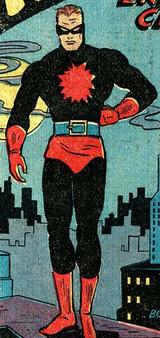
Firefly is a fictional comic book character created by Harry Shorten and Bob Wood for MLJ Comics in 1940. He first appeared in Top-Notch Comics #8. Artist Warren King and writer Joe Blair loaned their talents to many of the Firefly's installments.
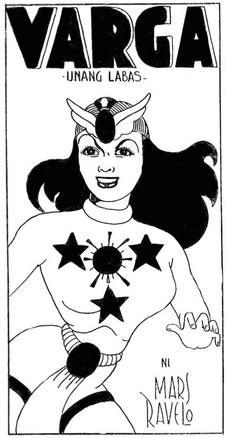
Varga, a Filipino comic superheroine, was created by Marcial "Mars" Ravelo and first appeared in Bulaklak Magazine in 1947. The character, originally named Varga and later known as Darna, is an alien princess from Planet Vergon. She possesses superhero abilities like flight, super strength, and psionic skills. Varga, recognized as the first female superhero in the Philippines, has been featured in various media, including films,TV shows and comic books.
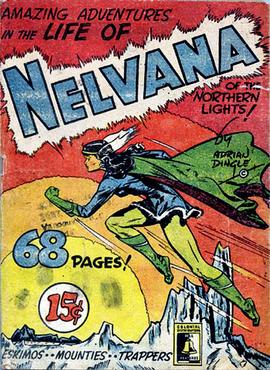
Nelvana of the Northern Lights is a Canadian comic book character and the first Canadian national superhero, debuting in Hillborough Studios' Triumph-Adventure Comics #1. She is also one of the first female superheroes, debuting before Wonder Woman, but after Fantomah, the Golden Age Black Widow, Invisible Scarlet O'Neil and others introduced in 1940. Nelvana of the Northern Lights is Canada's first distinctly Canadian female superhero.
















